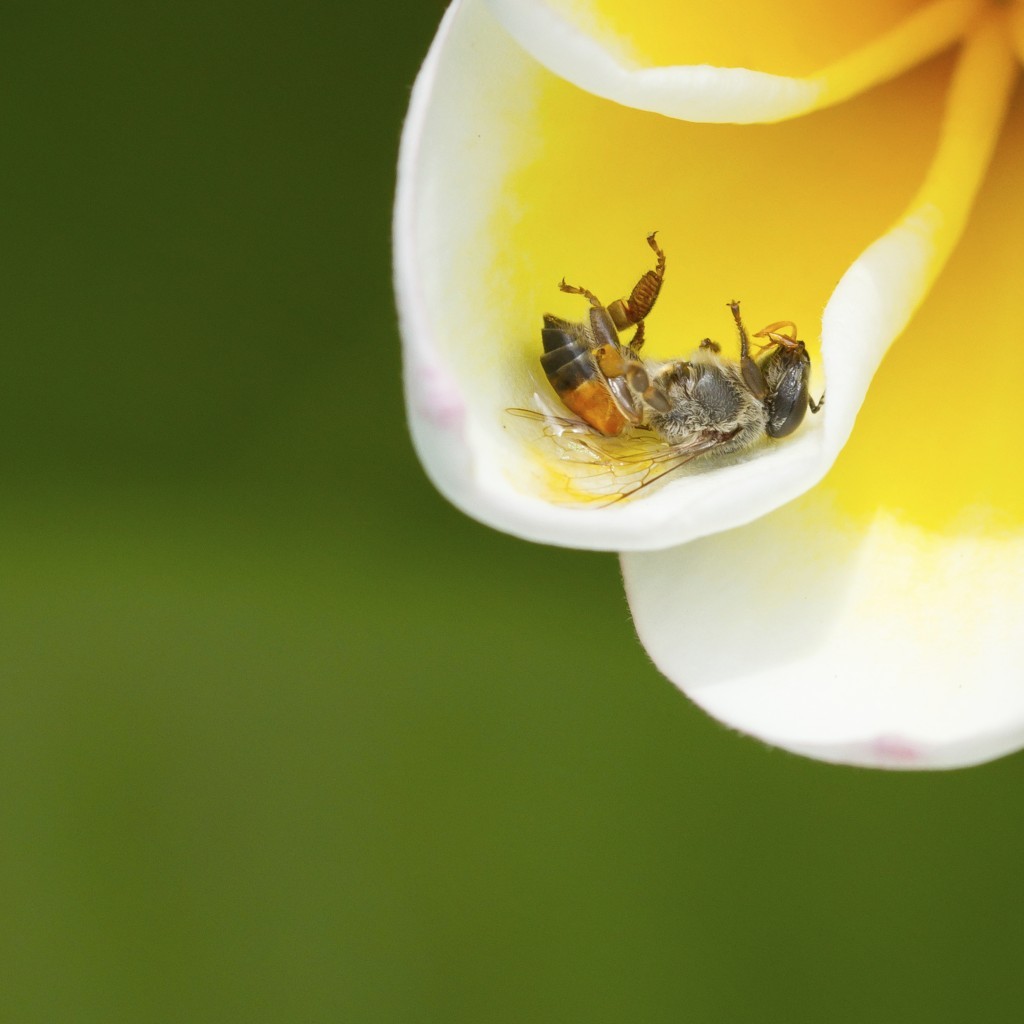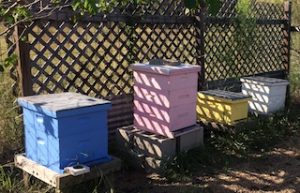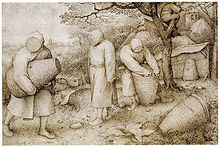
I love my bees. Their hives are pictured here in the late afternoon fall sunshine. I am told by my beekeeper that they are doing well and I expect honey next spring.  The different colors of the hives are to help the foraging bees easily find their home base. I enjoy linking my life to bee and honey lovers of ancient China, Babylonia, Crete and Israel. Sealed honey jars were found in the tomb of Tutankhamunin. Aristotle wrote lovingly of beekeeping as
The different colors of the hives are to help the foraging bees easily find their home base. I enjoy linking my life to bee and honey lovers of ancient China, Babylonia, Crete and Israel. Sealed honey jars were found in the tomb of Tutankhamunin. Aristotle wrote lovingly of beekeeping as did a variety of Romans including Virgil and Gaius. Pictured left is an 8000-year old cave painting of a woman harvesting honey in Spain.
did a variety of Romans including Virgil and Gaius. Pictured left is an 8000-year old cave painting of a woman harvesting honey in Spain.  She’s doing her work without bee ‘gear’ unlike the 16th century Europeans on the right, who are wearing some crazy face protection.
She’s doing her work without bee ‘gear’ unlike the 16th century Europeans on the right, who are wearing some crazy face protection.
Although it’s the bees, not the beekeepers, that need protection now. After Maryland lost about 60% of their hives last year (the national average is 42%) the State is banning sales of products that contain neonicotinoid pesticides. link It shouldn’t be a big surprise that a pesticide kills bees. In a recent, widely published article we learned that when researchers collected honey samples worldwide, 75% of the honey, including the honey we eat, contained neonicotinoids. link
We are assured that the half a dozen or so poisons classified as neonicotinoids are safe for mammals. Less toxic than caffeine, we are told by the manufacturers and growers. Only twice as toxic as ibuprofen. The same toxicity of wine! But Neonicotinoid pesticides are a first cousin to nicotine – you can see the word nicotine right in the long name. That sets off little warning bells, right?
We know all too well that humans have nicotine receptors. Neonicotinoids share “agonist activity” at nicotinic acetylcholine receptors (nAChRs). The effect they may have on our mammalian nAChRs is reported to be “unclear.” And our nAChRs are important for our brain development and function. Some odd “ratios” have been observed by scientists between control groups for autism spectrum disorder, memory loss and finger tremors. But there are very few studies to date. More study of these possible adverse effects has been recommended but not funded. link
Neonicotinoids poison insects by disrupting their central nervous systems, causing the inability to fly and/or disorientation, paralysis and eventually and always, death. They are applied to plant seeds or added directly to the soil, where the plant takes up the poison as it grows. The poison is then distributed throughout the vascular system of the plant and remains there 24/7. Any insect that drinks the morning dew on such a plant or eats its leaves or pollen is doomed. link
Of course, disease and overwork, also contribute to the decline of bees and I wrote abo ut that in December of last year. link But the use of neonicotinoids is increasing since it is so effective in the battle with the insects. Bees often drink the pollen of a treated plant, begin to lose neuron function, struggle home and feed the baby bees the poisoned pollen. Did I say neonicotinoids were effective? Growers are relying almost exclusively on these insecticides now and spray a field as much as 20 times a year, on a calendared schedule, not as needed. Also, these modern pesticides are about 6,000 times as toxic as older sprays. link
ut that in December of last year. link But the use of neonicotinoids is increasing since it is so effective in the battle with the insects. Bees often drink the pollen of a treated plant, begin to lose neuron function, struggle home and feed the baby bees the poisoned pollen. Did I say neonicotinoids were effective? Growers are relying almost exclusively on these insecticides now and spray a field as much as 20 times a year, on a calendared schedule, not as needed. Also, these modern pesticides are about 6,000 times as toxic as older sprays. link
Food labeled organic does not contain these poisons. Home Depot plans to stop selling plants that contain the poison in 2018; Lowe’s is working on the issue. Since the big box stores sell million of bedding plants to home owners each year this is helpful. The EU has restricted use of the poison, but because of new studies and political pressure the restrictions are being reconsidered.
About 85 percent of Earth’s flowering plants rely on pollination by bees and other pollinators and bees alone pollinate 30% or more of our food and beverages. What would Tutankhamunin think? Or Aristotle? Or as Dierks Bentley says in one of my favorite country music songs, What Was I Thinkin’.
Let’s keep our bees.